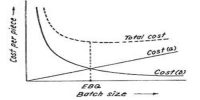Element-wise Classification of Cost
Cost can be defined as the monetary value of the utility (or benefit) which is yet to be derived from the resources used by the business to earn income.
Classification of the costs into element-wise, i.e. into the material, labor and expense is called element-wise classification. Here the total cost is analyzed on the basis of the nature of expenses. The different elements are the following:
(i) Direct Material
It is that material which can be identified in the product and conveniently measured and charged to the product. Direct materials form constituent elements of the final product.
The Chartered Institute of Management (CIMA), London defined Direct Material as “the cost of material entering into and becoming a constituent element of a product or saleable service and which can be identified separately in product cost.”
Wood in furniture, cloth in a shirt, leather in shoes, milk in chocolates, rubber in tire etc. are the examples of direct materials.
Direct materials include:
- All materials specially purchased for a particular process or job,
- All materials transferred from one process to another process,
- All primary packing materials like cardboard boxes, cartons, wrapping etc.
However in some cases, through the material is a part of the finished product, it is not treated as direct materials, for example, sewing thread in dressmaking, glue in bookbinding. This is because they are used comparatively in small .quantities and their value is very less compared to the cost of other main materials used. Such materials are treated as indirect materials.
(ii) Direct Labor
The term labor refers to the human effort required to perform an activity. Labor costs or wages is the compensation paid for the human effort. Direct labor is the labor which can be conveniently identified with or attributed completely to a particular job, product or process. It is the labor directly engaged in production.
CIMA of London defines it as “the cost of remuneration for employee’s efforts and skills applied directly to a product or saleable service and which can be identified separately in product costs.”
All labor that is directly involved in converting raw materials into finished goods, altering the construction, composition, and condition of the products is direct labor. Remuneration paid to direct labor is known as direct labor cost or direct wages. Direct wages include payments made to:
- Labor engaged in the actual production.
- Inspectors, supervisors, analysts etc. specially required for such production.
- All associated expenditure paid by the employer in employing direct labor such as cost of free transportation facilities, cost of free lunch, free medical facilities etc.
(iii) Direct Expenses or Chargeable Expenses
Expenses other than direct material or direct labor which are specifically occurred for a particular product or process are known as direct expenses or chargeable expenses. They can be identified with and allotted to cost units or cost centers.
According to CIMA, London, direct expenses are identified as “costs other than material or labor which can be identified in a specific product or saleable service.”
Examples of direct expenses are:
- Cost of special drawings, layouts or designs.
- Hire charges and repair and maintenance of special equipment hired for a job.
- Experimental expenses of a job.
- Excise duty, royalty, architects or surveyors fee etc.
(iv) Indirect Cost
All those expenses which are not classified as direct are brought under indirect cost. Indirect cost is defined as one that cannot be identified conveniently with the output or the cost objective. Indirect cost comprises indirect material cost, indirect labor cost, and indirect expenses.
Indirect Materials: Materials which do not form part of a product are indirect materials. Grease, oil, lubricants, cotton waste, sandpaper, chemicals added in production processes, stores required for service and maintenance departments are examples of indirect materials. The materials of very small value are also treated as indirect materials. The thread used in dress, nails used in wooden box, the glue used in books etc., are such expenses, which thought form a part of the product, are treated as indirect materials as they have only very small value compared to the cost of main materials used. Cost of indirect materials cannot be allocated to products or processes but are apportioned to them on some equitable basis.
Indirect Labor: All human effort which is not directly spent in the manufacture of a product or output conies under this category. Wages paid to persons who facilitate or assist the direct labor in the manufacturing process are known as indirect labor cost. Indirect labor cannot be identified with a job, process or operation. Salary paid to a clerk who works in the office of a manufacturing concern is indirect labor. Though his services are essential for running the business as a whole, he is not engaged in the production activity. Similarly, remuneration paid to managers, foremen, accountants, salesmen, supervisors, inspectors, etc., comes under indirect labor cost. The cost of indirect labor cannot be allocated to products or processes, but are apportioned on some equitable basis.
Indirect Expenses: Expenses which are not directly related to product/service are known as indirect expenses. These cannot be allocated conveniently and wholly to any product or process but are only apportioned to or absorbed by cost units or cost centers. Expenses like an insurance premium, rent, lighting, water charges, depreciation, power, advertisements, canteen expenses etc., are indirect expenses.
All indirect costs arc collectively known as “overheads”. It is the total of indirect material cost, indirect labor cost, and indirect expenses not incurred for any particular product, but for the business as a whole.
















